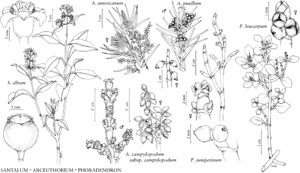Santalaceae
Shrubs or trees, root parasites [stem parasites], evergreen or deciduous, synoecious or dioecious [monoecious, andromonoecious]. Leaves opposite [alternate, whorled], simple; stipules absent; petiole present; blade margins entire; venation pinnate. Inflorescences unisexual or bisexual, axillary or terminal, thyrses or umbels [spikes, racemes, cymes, panicles, fascicles], or flowers solitary. Flowers bisexual or unisexual; perianth and androecium perigynous or epigynous; hypanthium adnate to ovary proximally, free distally [completely adnate to ovary]; sepals 0; petals 3–4 (–5), distinct, valvate, post-staminal hairs present or absent; nectary present [absent]; stamens 3–4 (–5), opposite petals, distinct, free; anthers dehiscing by longitudinal slits; staminodes present in pistillate flowers; pistil 1, 1–3-carpellate, ovary 1/2-inferior or inferior, 1–3-locular proximally, 1-locular distally, placentation free-central, pendulous; ovules 2–4 per ovary, anatropous; style 1; stigma 1. Fruits pseudodrupes (mesocarp hard). Seeds 1 per fruit.
Distribution
Nearly worldwide
Discussion
Genera 11, species 67 (2 genera, 2 species in the flora).
This circumscription of Santalaceae in the strict sense derives from the molecular phylogenetic results of J. P. Der and D. L. Nickrent (2008). That study yielded a strongly supported clade of 11 genera that contains a diverse array of life forms from root parasitic trees and shrubs to aerially parasitic mistletoes, including three genera that previously have been segregated as Eremolepidaceae. Nestronia, the only genus of Santalaceae native to North America, is sister to Colpoon P. J. Bergius and Rhoiacarpos A. de Candolle, both South African endemics. These three genera, as well as Osyris Linnaeus, share a number of morphologic features, including habit, epigynous flowers, anther morphology, presence of nectaries, and fruit type; they previously have been classified in Santaleae A. de Candolle (= Osyrideae Reichenbach). Using phylogenetic trees calibrated for time with fossil evidence, it appears that Nestronia diverged from its Old World relatives in the Eocene.

